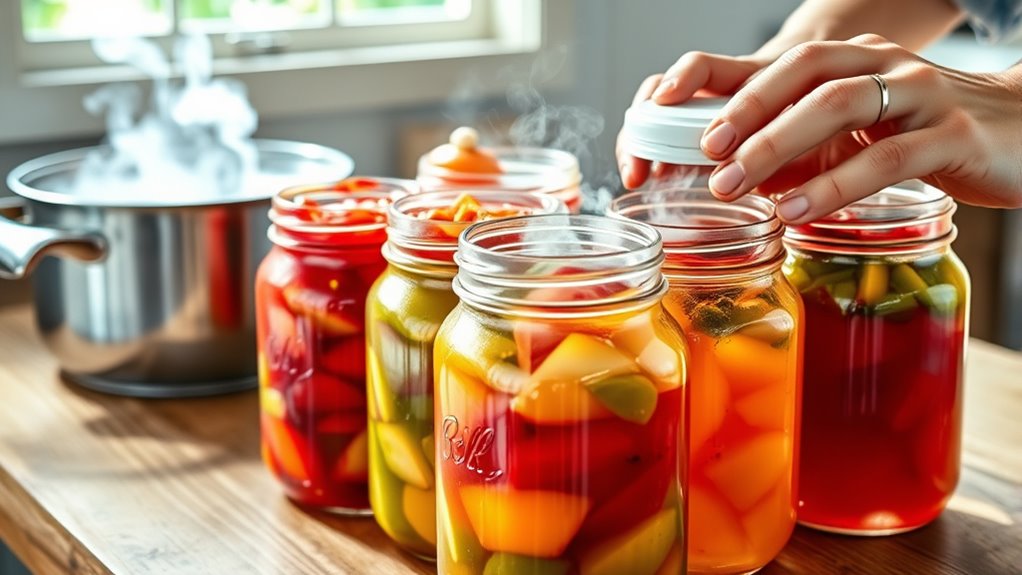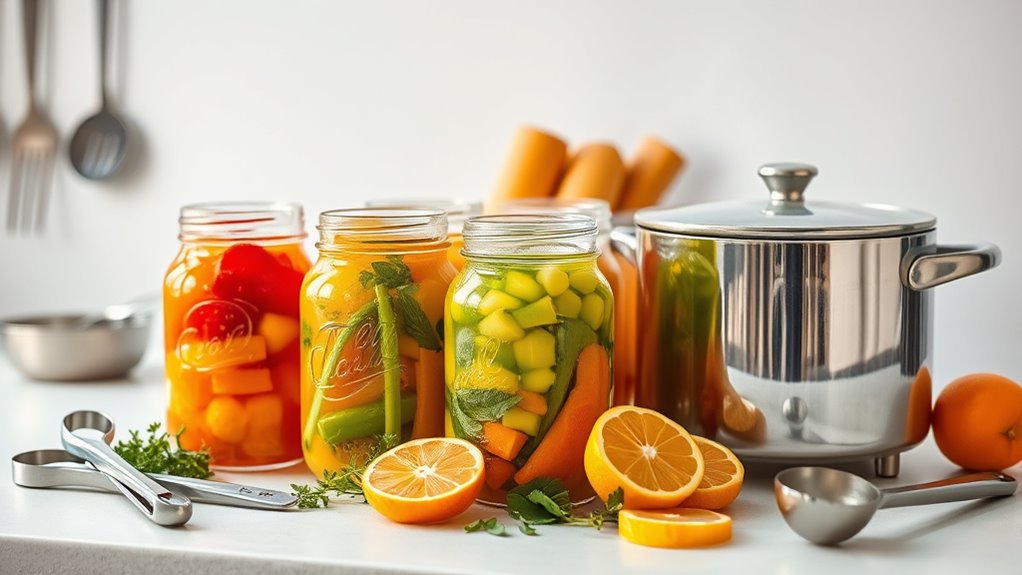To can and preserve food safely at home, follow tested recipes from reliable sources and use proper techniques like boiling water bath for acidic foods or pressure canning for low-acid items. Sterilize jars thoroughly, process them for the correct time, and guarantee jars seal properly. Store canned goods in a cool, dark place and regularly check for signs of spoilage. Keep these safety tips in mind, and you’ll be well on your way to safe, delicious preserved foods.
Key Takeaways
- Always use tested recipes and proper sterilization techniques to prevent contamination and ensure safety.
- Choose appropriate preservation methods: boiling water bath for acidic foods and pressure canning for low-acid items.
- Follow precise processing times and consider altitude adjustments to eliminate harmful microorganisms effectively.
- Ensure jars are sealed correctly with intact lids and bands to create an airtight environment for safe long-term storage.
- Regularly inspect stored canned goods for signs of spoilage and store in a cool, dark, dry place to maintain quality and safety.

Canning and preserving food at home can be a rewarding way to enjoy fresh flavors year-round, but it’s essential to follow proper safety guidelines. When you’re working with preserved foods, guaranteeing food safety is the top priority to prevent spoilage and foodborne illnesses. The key lies in understanding and applying correct preservation techniques that eliminate or inhibit bacteria, yeasts, and molds. These techniques include boiling water bath canning for acidic foods and pressure canning for low-acid items, both designed to achieve the necessary heat levels to kill harmful microorganisms. Ignoring these methods can lead to unsafe products that might look, smell, or taste fine but pose serious health risks.
To start, always use tested recipes from reliable sources, such as extension services or reputable canning guides. These recipes are carefully developed to include the right combination of acid, sugar, and processing time, which are critical components of food safety. When preparing your jars, sterilize them thoroughly—either by boiling or running them through a dishwasher cycle—before filling. This step helps prevent contamination from the outset. Additionally, ensure that your lids and bands are in good condition and properly sealed after processing, creating an airtight environment that keeps bacteria at bay.
Preservation techniques must be executed with precision. For example, if you’re canning tomatoes or fruit, using a boiling water bath is appropriate because their acidity prevents botulism growth. Conversely, low-acid vegetables or meats require pressure canning, which reaches higher temperatures necessary to destroy dangerous bacteria like Clostridium botulinum. Always follow recommended processing times based on your altitude and jar size, as insufficient processing can leave spores alive, risking spoilage or illness. After processing, let jars cool undisturbed and check seals before storing. A proper seal indicates that the jar is safe for long-term storage.
Another important aspect of food safety is proper storage. Keep your canned goods in a cool, dark, and dry place to prolong shelf life and prevent spoilage. Regularly inspect jars for any signs of spoilage, such as bulging lids, leaks, or foul odors, and discard any suspicious contents. By practicing these preservation techniques diligently, you guarantee your preserved foods remain safe and delicious, allowing you to enjoy the fruits of your labor without worry. Remember, patience and attention to detail are your best tools for successful and safe home canning.
Frequently Asked Questions
Can I Reuse Canning Jars and Lids Safely?
You might wonder if you can reuse canning jars and lids safely. It’s best to sterilize canning jars thoroughly before each use to prevent contamination. Reusing jar lids isn’t recommended because they can lose their sealing ability, risking spoilage. Instead, consider reusing jars with new lids or investing in new canning lids to ensure a proper seal. Always prioritize safety by following proper sterilization procedures and using the right lids.
How Do I Prevent Mold Growth During Storage?
Think of your preserved food as a delicate garden needing protection. To prevent mold growth, you must create the perfect environment. Keep storage conditions cool, dark, and dry—like a cozy cave for your jars. Guarantee lids are sealed tight, and check periodically for any signs of moisture or damage. Proper mold prevention means maintaining these ideal conditions, so your preserved bounty stays fresh and safe, blooming beautifully until you’re ready to enjoy it.
What Are Signs of Spoilage in Canned Foods?
If you suspect spoilage in canned foods, look for signs like bulging lids, leaks, or foul odors, which indicate improper sealing and a higher botulism risk. Discoloration, mold, or a slimy texture also signal spoilage. Never taste or smell canned food to assess safety—these signs help you avoid health risks from bacteria or toxin formation. Always discard any suspicious cans to keep safe.
Is It Safe to Can Low-Acid Vegetables Without Pressure Canning?
Caution is essential when canning low-acid vegetables, as they demand precise preserving techniques to prevent perilous pathogens. Without pressure canning, you risk unsafe spoilage because these vegetables lack the acidity needed to inhibit bacteria. Acidic foods can often be canned with water bath methods, but low-acid foods require pressure canners. Always adhere to authoritative guidelines to assure safe food storage and savor the safety of your preserved produce.
How Long Can I Store Home-Canned Foods Safely?
You can typically store home-canned foods for up to one year for the best quality and safety. Proper storage duration, or shelf life, depends on how well you seal and store your jars in a cool, dark place. After this period, the food might still be safe, but quality can decline. Always check for signs of spoilage before consuming, and prioritize safety over storage duration.
Conclusion
By following proper canning and preservation techniques, you guarantee your food stays safe and delicious for months. Did you know that home-canned foods retain over 90% of their nutrients when done correctly? This statistic highlights how safe, nutritious, and cost-effective your efforts can be. So, keep learning and practicing safe methods—your family will enjoy the benefits of homemade preserves, and you’ll feel confident knowing you’re preserving food the right way.










